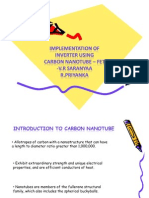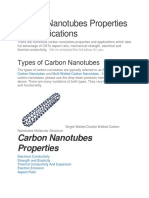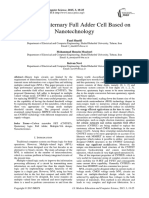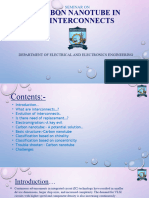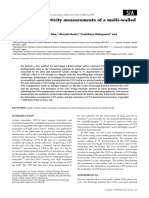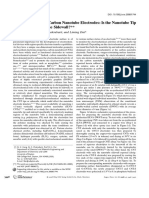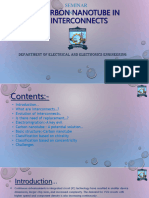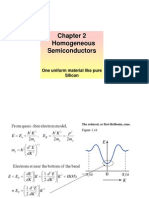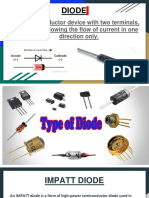0 ratings0% found this document useful (0 votes)
111 viewsCNTFET
CNTFET
Uploaded by
RavishankerThis document provides a review of carbon nanotube field effect transistors (CNTFETs). It discusses the basic structure and operation of CNTFETs, which use a carbon nanotube as the channel material instead of bulk silicon. The document outlines the key characteristics and advantages of CNTFETs, such as ballistic transport, stable surface bonds, and no dangling bonds at interfaces. It also categorizes the different types of CNTFETs that have been developed, including back-gated, top-gated, wrap-around gate, and suspended structures. The review concludes by discussing doping techniques and the promise of CNTFETs to replace traditional MOSFETs in nanoscale electronics.
Copyright:
© All Rights Reserved
Available Formats
Download as DOC, PDF, TXT or read online from Scribd
CNTFET
CNTFET
Uploaded by
Ravishanker0 ratings0% found this document useful (0 votes)
111 views6 pagesThis document provides a review of carbon nanotube field effect transistors (CNTFETs). It discusses the basic structure and operation of CNTFETs, which use a carbon nanotube as the channel material instead of bulk silicon. The document outlines the key characteristics and advantages of CNTFETs, such as ballistic transport, stable surface bonds, and no dangling bonds at interfaces. It also categorizes the different types of CNTFETs that have been developed, including back-gated, top-gated, wrap-around gate, and suspended structures. The review concludes by discussing doping techniques and the promise of CNTFETs to replace traditional MOSFETs in nanoscale electronics.
Copyright
© © All Rights Reserved
Available Formats
DOC, PDF, TXT or read online from Scribd
Share this document
Did you find this document useful?
Is this content inappropriate?
This document provides a review of carbon nanotube field effect transistors (CNTFETs). It discusses the basic structure and operation of CNTFETs, which use a carbon nanotube as the channel material instead of bulk silicon. The document outlines the key characteristics and advantages of CNTFETs, such as ballistic transport, stable surface bonds, and no dangling bonds at interfaces. It also categorizes the different types of CNTFETs that have been developed, including back-gated, top-gated, wrap-around gate, and suspended structures. The review concludes by discussing doping techniques and the promise of CNTFETs to replace traditional MOSFETs in nanoscale electronics.
Copyright:
© All Rights Reserved
Available Formats
Download as DOC, PDF, TXT or read online from Scribd
Download as doc, pdf, or txt
0 ratings0% found this document useful (0 votes)
111 views6 pagesCNTFET
CNTFET
Uploaded by
RavishankerThis document provides a review of carbon nanotube field effect transistors (CNTFETs). It discusses the basic structure and operation of CNTFETs, which use a carbon nanotube as the channel material instead of bulk silicon. The document outlines the key characteristics and advantages of CNTFETs, such as ballistic transport, stable surface bonds, and no dangling bonds at interfaces. It also categorizes the different types of CNTFETs that have been developed, including back-gated, top-gated, wrap-around gate, and suspended structures. The review concludes by discussing doping techniques and the promise of CNTFETs to replace traditional MOSFETs in nanoscale electronics.
Copyright:
© All Rights Reserved
Available Formats
Download as DOC, PDF, TXT or read online from Scribd
Download as doc, pdf, or txt
You are on page 1of 6
Carbon nanotubes field effect transistors: A review
RamBabu.B1, Dr.Y.Srinivasa Rao2, P.Swapna3, K.Kalyan Babu4
1
Department of Electronics and Instrumentation Engineering, Sir.C.R.R.College of Engineering, Eluru.
2,3
Department of Instrument Technology, Andhra University, India
4
Department of Electronics and Communication Engineering, GITAM University, Vizag.
rams1315@gmail.com1, srinniwasarau@gmail.com
2
the other hand, annealing a device may operate in
Abstract- Carbon Nanotube CNTFET in vacuum ballistic regime.
Field Effect Transistors promotes electron conduction ▪ The nanotube conducts
(CNTFET) are promising
nano-scaled devices for via a completely different essentially on its surface
implementing high mechanism: the presence of where all the chemical bonds
performance very dense and atmospheric oxygen near the are saturated and stable. In
low power circuits. A Carbon metal/nanotube contacts other words, there are no
Nanotube Field Effect affects the local bending of dangling bonds which form
Transistor refers to a FET the conduction and valence interface states. Therefore,
that utilizes a single CNT or
an array of CNT’s as the
bands in the nanotube by way there is no need for careful
channel material instead of of charge transfer, and the passivation of the interface
bulk silicon in the traditional Fig 1: Early CNTFET structure. Fermi level is pinned close to between the nanotube
MOSFET structure. The core the valence band, making it channel and the gate
of a CNTFET is a carbon Following these easier for injection of holes. dielectric, i.e. there is no
nanotube. In this paper, the initial CNTFET results When the oxygen is desorbed equivalent of the
review of CNTFETs is
advances in CNTFET device at high temperatures, the silicon/silicon dioxide
presented. The structure,
operation and the structures and processing Fermi level may line up interface.
characteristics of different yielded improvements in closer to the conduction ▪ The Schottkey barrier at the
types of CNTFET’s have been their electrical characteristics. band, allowing injection of metal-nanotube contact is the
discussed. The operation, dc Rather than laying the electrons. Contrary to the active switching element in
characteristics of CNTFETs nanotube down upon the case of bulk doping, there is an intrinsic nanotube device.
have been presented and no threshold voltage shift
analysis of the performance of
source and drain electrodes,
various characteristics. relying on weak vander walls when going from p-type to n- With these unique
forces for contact, the type by thermal annealing. In features CNTFET becomes a
Keywords—CNTFET, Carbon
electrodes were patterned on addition, it is possible to device of special interest.
nanotubes, Field effect
transistors, Nanoelectronics, top of previously laid down achieve an intermediate state,
characteristics CNs. In addition to Au, Ti in which both electron and 1.1 Type of CNTFET
and CO were used, with a hole injection are allowed, The field effect
I. INTRODUCTION thermal annealing step to resulting in ambipolar transistors made of carbon
improve the metal/nanotube conduction. nanotubes so far can be
The first carbon nanotube
contact. In the case of Ti, the classified into:
field-effect transistors were
thermal processing leads to Carbon nanotube a) Back gate CNTFET
reported in 1998. These were
the formation of TiC at the field effect transistor b) Top gate CNTFET
simple devices fabricated by
metal/nanotube interface, (CNTFETs) uses semi c) Wrap-around gate
depositing single-wall CNTs
resulting in a significant conducting carbon nanotube CNTFETs
(synthesized by laser
reduction in the contact as the channel. Both p- d) Suspended CNTFETs
ablation) from solution onto
resistance from several MΩ channel and n-channel
oxidized Si wafers which had
to 30 kΩ. On state currents devices can be made from Other then this 4
been prepattemed with gold
~1μA were easured, with nanotubes. The physical biggest classes, some
or platinum electrodes. The semiconductor company have
transconductance - 0.3 μS. structure of CNTFETs is very
electrodes served as source been proposed their own
All early CNTFET similar to that of
and drain, connected via the new/next generation Carbon
were p-type, i.e., hole MOSFETs and their I-V
nanotube channel, and the Nanotube FET such as Infineon
conductors. Whether this was characteristics and transfer introduced their vertical carbon
doped Si substrate served as
due to contact doping or characteristics are also very nanotube FET (VCNTFET)
the gate. A schematic of such
doping by the adsorption of promising and they suggest concept in year 2003.
a device is shown in Fig.1.
oxygen from the atmosphere that CNTFETs have the
Clear p-type transistor action
was initially unclear. N-type potential to be a successful a) Back-gated CNTFET’s
was observed, with gate
conduction was achieved by replacement of MOSFETs in
voltage modulation of the
doping from an alkali nanoscale electronics. Of The earliest
drain current over several
(electron donor) gas and by course, there are some techniques for fabricating
orders of magnitude. The
thermal annealing in vacuum. distinct properties of carbon nanotube (CNT) field-
devices displayed high on-
Doping by exposure to an CNTFETs, such as: effect transistors involved
state resistance of several
alkali gas involves charge ▪ The carbon nanotube is one- pre-patterning parallel strips
MQ, low transconductance (-
transfer within the bulk of the dimensional, which greatly of metal across a silicon
Ins) and no current
nanotube, analogous to reduces the scattering dioxide substrate, and then
saturation, and they required
doping in conventional probability. As a result the depositing the CNTs on top
high gate voltages (several
volts) to turn them on. semiconductor materials. On in a random pattern [1]. The
semiconducting CNTs that CNTFET employing metallic Wrap-around gate transferring them onto a
happened to fall across two Co or TiC contacts. CNTFETs, also known as substrate and then under-
metal strips meet all the b) Top-gated CNTFET’s gate-all-around CNTFETs etching the dielectric beneath
requirements necessary for a were developed in 2008 [7], and transfer-printing onto
rudimentary field-effect Eventually, [3],and are a further a trenched substrate [6].
transistor. One metal strip is researchers migrated from the improvement upon the top-
the “source” contact while back-gate approach to a more gate device geometry. In this
the other is the “drain” advanced top-gate fabrication device, instead of gating just
contact. The silicon oxide process [2]. In the first step, the part of the CNT that is
substrate can be used as the single-walled carbon closer to the metal gate
gate oxide and adding a metal nanotubes are solution contact, the entire
contact on the back makes deposited onto a silicon oxide circumference of the
Fig 4: Suspended CNTFET device.
the semiconducting CNT substrate. Individual nanotube is gated. This
gateable. nanotubes are then located should ideally improve the
electrical performance of the The main problem
via atomic force microscope
CNTFET, reducing leakage suffered by suspended
or scanning electron
current and improving the CNTFETs is that they have
microscope. After an
device on/off ratio. very limited material options
individual tube is isolated,
for use as a gate dielectric
source and drain contacts are
(generally air or vacuum),
defined and patterned using
and applying a gate bias has
high resolution electron beam
the effect of pulling the
lithography. A high
nanotube closer to the gate,
temperature anneal step
which places an upper limit
reduces the contact resistance
Fig 3: Sheathed CNT on how much the nanotube
by improving adhesion
Device fabrication begins by can be gated. This technique
between the contacts and
Fig 2: Top and side view of carbon first wrapping CNTs in a gate will also only work for
CNT. A thin top-gate
nanotubes deposited on a silicon dielectric and gate contact via shorter nanotubes, as longer
oxide substrate pre-patterned with dielectric is then deposited on
atomic layer deposition [4]. tubes will flex in the middle
source and drain contacts. top of the nanotube, either
These wrapped nanotubes are and droop towards the gate,
via evaporation or atomic
then solution-deposited on an possibly making touching the
The types of back layer deposition. Finally, the
insulating substrate, where metal contact and shorting
gate CNTFETs discussed so top gate contact is deposited
the wrappings are partially the device. In general,
far have high contact on the gate dielectric,
etched off, exposing the ends suspended CNTFETs are not
resistances (≥1 MΩ), which completing the process.
of the nanotube. The source, practical for commercial
led to a low transconductance
drain, and gate contacts are applications, but they can be
gm (=dI/dVG) of about 10 Arrays of top-gated
then deposited onto the CNT useful for studying the
-9A/V. This large contact CNTFETs can be fabricated
ends and the metallic outer intrinsic properties of clean
resistance results from the on the same wafer, since the
gate wrapping. nanotubes.
weak van der Waals coupling gate contacts are electrically
of the devices to the noble isolated from each other,
metal electrodes in the ‘side- unlike in the back-gated case. d) Suspended CNTFET’s 1.2 Other CNTFET
bonding’ configuration used. Also, due to the thinness of
Here the SWNT is dispersed the gate dielectric, a larger CNTFET device The CNTFET
on top of the SiO2 film, and electric field can be geometry involves technology is at an early
then source and drain generated with respect to the suspending the nanotube over stage; devices structures are
electrodes made of transition nanotube using a lower gate a trench to reduce contact still primitive and the devices
metals compatible with voltage. These advantages with the substrate and gate physic still relatively
silicon technology, such as Ti mean top-gated devices are oxide [5]. This technique has unexplored. So, other the
or Co, are fabricated on generally preferred over the advantage of reduced most popular Back Gate and
SWNT. Subsequent anneals back-gated CNTFETs, scattering at the CNT- Top Gate structures, some of
at 400º C (Co) and, or at 820º despite their more complex substrate interface, improving the researcher also proposed
C (Ti) in an inert ambient, fabrication process. device performance [5] [6] their own structure such as
form low resistance Co [7]. There are many methods N-Type, AMBIPOLAR
contacts or TiC contacts at c) Wrap-around gate used to fabricate suspended CNTFET, Vertical Gate, and
the source and drain CNTFET’s CNTFETs, ranging from etc. to prove the performance
electrodes. Fig shows I-V growing them over trenches of the transistor is better after
characteristics of p-type using catalyst particles [5], the channel of the transistor
replaced by CNT. Below are keeps the n-type devices 1.2.3 Vertical The current voltage
several examples of the stable. CNTFET curve can be divided into two
differences structure of regions: linear and saturation.
CNTFET. If a CNTFET with This vertical Carbon Drain current in the linear
SiO2 protective film is Nanotube FET has been region of CNTFET can be
1.2.1 N-Type and annealed in vacuum or in proposed by the researcher in described as follows:
AMBIPOLAR CNTFET inert atmosphere, the initial Infineon Technology. The
p-type device is gradually concept is totally difference
The capability to transformed into an compared to traditional
produce n-type transistors is ambipolar FET, i.e., the MOSFET vertical gate
important technologically, as device, depending on the sign configuration. Fig.6 showed Or
it allows the fabrication of of the gate voltage VG, can the first draft of the Vertical
CNT-based complementary operate as switches for CNTFET proposed by
logic devices and circuits. A electrons and holes. These Infineon in year 2003. [10]
back gated n-type nanotube ambipolar transistors are Where Kn is conductance of
transistor can be obtained by stable in air and show ohmic CNTFET, W is the width of
doping the nanotube with I-VDS curves in both the CNTFET, L is the length of
potassium vapor. The strong hole accumulation and CNTFET, μ is mobility of
mechanism is that electron inversion (electron carriers, Cox is gate
transfer from adsorbed accumulation) regimes. This capacitance.
potassium atoms to the behaviour suggests that the
nanotube can shift the Fermi effective contact barriers for We can also obtain
level of the tube from the both electron and hole saturation current of
valence-band edge to the transport are very small. CNTFET by replacing Vds(sat)
conduction band edge, thus = Vgs – VT. Then the
reverting the doping from p- 1.2.2 Multi WALL Fig .6: Vertical CNTFET expression of saturation
to n-type. [8] Fig.5 shows the CNTFET current of CNTFET can be
schematic of setup for doping written:
and the resulting I-V The complexity of
characteristics. structure of multi wall 2.0 Characteristics of
nanotube (MWNT) has CNTFET’s
discouraged their detailed
study and use. In principle, The drain I-V
each of its carbon shells can characteristics in 2D are shown
in fig 7. The saturation current at 2.1 I-V characteristics
be metallic or
VGS = 0.5 V is around 6 μA,
semiconducting with which is not inconsistent with
Fig 5: Schematic diagram of the different chiralities. Also, values emerging from recent
potassium doping setup. these shells can interact. It experimental work [9].
has been found that in
An n-type top gate MWNTs side-bonded to
device as shown in Fig 3.9 metal electrodes, effectively
(a) can be obtained by an in only the outer shell
situ annealing step prior to contributes to electrical
the deposition of the gate transport. One would
dielectric film. Thermal therefore expect that MWNTs
treatment in an inert with semiconducting outer
atmosphere drive off the shell can be used to fabricate Fig 8: Output characteristics of n-
adsorbed oxygen from the CNTFETs. However, since Fig 7: Drain current-voltage
type CNTFET
source and drain contact the bandgap in characteristics of planar CNTFET.
regions, shifts the Fermi level semiconducting CNTs is
at the contacts and effectively inversely proportional to the Drain I-V characteristics
lowers the barrier for electron tube diameter, only small exhibited dependence of
injection, which results in an diameters MWNTs are saturation drain current on
n-type behaviour. The oxide expected to exemplify FET temperature. When CNTFET
film protects the nanotube characteristics at room is cooled, drain saturation
from the ambient gases and temperature. [9] currents were lightly
decreased.
Fig 9: Output Characteristics for a p- reflect a similar scenario. For this limit, all the other curves process variation should be
type top gated CNTFET
an applied drain voltage, the representing the higher focused for this moment.
current increases almost values of Vds are almost
As the voltage quadratically as soon as a merged. The electron current 4 REFERENCES
across the gate and the source gate voltage is applied. The beyond this point is [1] Martel, R.; Schmidt, T.;
of SB-CNTFET is increased two drain and transfer independent of Vds. Shea, H. R.; Hertel, T.;
from 0 volts, the Fermi level characteristics show that the Avouris, Ph. (1998).
of the nanotube moves closer current .owing through the 3 Conclusions "Single- and multi-wall
to the conduction band. This device is very sensitive to the Carbon Nanotubes carbon nanotube field-
band lowering effect causes drain voltage and is largely are considered as the most effect transistors".
barriers to develop at controlled by manipulating promising carbon Applied Physics Letters
nanotube-metal junctions. the barrier height at the nanostructure material is 73.
The electrons which have contacts. realizing the nano-electronic [2] Wind, S. J.;
enough potential will cross transistors back in year 1991. Appenzeller, J.; Martel,
the barrier and flow into the The understanding of carbon R.; Derycke, V.;
tube, causing leakage current. nanotube transistor is Avouris, Ph. (2002).
In our model, the main evolving and the performance "Vertical scaling of
source of leakage is the of the transistor is improving carbon nanotube field-
thermionic current. When a very rapidly. CNTFET effect transistors using
positive voltage is applied on devices present a bright top gate electrodes".
the drain, the barrier spike Fig 10: CNTFET sub threshold future and promise to sustain Applied Physics Letters
begins to progressively Drain characteristics
FET scaling and Moore’s 80: 3817.
diminish at that end of the Law should their practical [3] Chen, Zhihong; Farmer,
channel. The barrier and manufacturing problems Damon; Xu, Sheng;
thickness, as seen by the be overcome.The V-I Gordon, Roy; Avouris,
charge carriers, begins to characteristics of top gated Phaedon; Appenzeller,
reduce too. Consequently, the CNTFET are also described. Joerg (2008).
electrons induced on the The main analysis is studies "Externally Assembled
channel can now enter the on the I-V characteristics of Gate-All-Around
drain metal by tunnelling Fig 11: CNTFET sub threshold
the CNTFET. These top
Transfer characteristics Carbon Nanotube
through the barrier while gated CNTFET devices Field-Effect Transistor".
those carriers with sufficient exhibit excellent electrical
We can see from IEEE Electron Device
thermal energy can jump characteristics. However, as
Fig. 10 that for a given V gs, Letters 29: 183.
over the barrier. The limiting was mentioned above, the
the current saturates at the [4] Farmer, DB; Gordon,
value of current through the control parameter of the
region, i.e., when the applied RG (2006). "Atomic
nanotube is described by the properties of the carbon
Vds ≈ generate the transistor layer deposition on
thermionic current nanotube will change the
I-V characteristics and their suspended single-
component. drain current directly and the
dependence on the gate walled carbon
dielectric thickness and channel length does not nanotubes via gas-
See from the figure,
nature of the insulator barrier impacting the performance phase noncovalent
that when no gate voltage is
height. At this point the much. A multitude of oxide fictionalization". Nano
applied, for the case of Vgs =
barrier is entirely suppressed can be placed on the letters 6 (4): 699–
0 in Fig. 8, the current
and there is maximum nanotube and thus, many 703M.
increases linearly with Vds.
current flow through the high-k dielectrics can be [5] Cao, J; Wang, Q; Dai, H
This is attributed to the linear
channel. Fig. 11 shows an incorporated into CNTFET to (2005). "Electron
dependence of the thermionic
almost linear increase in the reduce the tunneling current. transport in very clean,
current on the drain voltage.
current as a function of the The large potential of as-grown suspended
The application of a positive
gate voltage. The onset of CNTFET transistor to carbon nanotubes".
gate voltage induces heavy
current saturation as a semiconductor industry and Nature materials 4 (10):
charge on the channel. It can
function of drain voltage is microelectronic system due 745–9
be seen from the same figure
expressed very clearly here. the large Ion: Ioff , high current [6] Sangwan, V. K.;
that the current due to charge,
The plot consists of 5 curves drive and other special Ballarotto, V. W.;
tunnelling through the barrier
for Vds ranging from 0 – 1 V. properties of carbon Fuhrer, M. S.; Williams,
at the drain end, is
However, while there is a nanotube. However, the E. D. (2008). "Facile
significantly greater than the
marked increase in the carbon nanotube field still in fabrication of
thermionic current
current for an increase of Vds the early stage and the suspended as-grown
component. The transfer
from 0.1V to 0.3V, beyond technology for reducing the carbon nanotube
characteristics in Fig. 9
devices". Applied India. He is having 15+years of research papers in the National
Physics Letters 93: teaching and research experience Conferences. His present
113112.FLEXChip and published more than 50 research focuses on Carbon
research papers in the Nanotube Electronics including
Signal Processor
International journals and modelling, Simulation Design
(MC68175/D), presented few of them in the and Fabrication of Carbon
Motorola, 1996. International Conferences. He Nanotube on flexible Electronic
[7] Lin, Yu-Ming; Tsang, will be an Visiting Researcher, devices. He is a life member of
James C; Freitag, EEE Department, Nanyang ISTE.
Marcus; Avouris, Technological University,
Phaedon (2007). Singapore in 2012. He had
"Impact of oxide received “Emerald Literati
substrate on electrical Network 2008 Outstanding
Paper Award (UK)”, three
and optical properties
“Best Paper Awards” (one in
of carbon nanotube 2011 and twice in 2007),
devices". “Vignan Pratibha Award –
Nanotechnology 18: 2006” from Andhra University
295202. and selected as “Science
[8] R. Martel et al., Researcher” for Asia – Pacific
“Ambipolar Electrical region in 2005 by UNESCO and
Transport in Australian Expert group in
Semiconducting Single- Industry Studies (AEGIS) at the
University of Western Sydney
Wall Carbon (UWS) and received “Young
Nanotubes,” Phys. Rev. Scientist Award” from
Lett. (2001). Department of Science and
[9] R. Martel, T. Schmidt, Technology, Govt. of India in
H.R. Shea, T. Hertel, 2002. He is acting as Reviewer
and Ph. Avouris, for several International and
Single- and Multi- National Journals. His present
wall Carbon Nanotube research focuses on Carbon
Nanotube Electronics including
Field-effect Transistors,
modelling, Simulation Design
Applied Physics Letters, and Fabrication of Ambipolar
October 1998. Carbon Nanotube Transistors
[10] S. J. Wind et al., and Ambipolar electronic
Vertical scaling of devices and also Thick and Thin
carbon Nanotube film devices. He is a life member
Field-effect transistors of ISTE and member of IMAPS
using top gate electrodes, (USA and India).
Applied
Physics Letters, May
2002.
Ram Babu. B received his
M.Tech in Electrical and
Instrumentation Engineering
Dr.Y.Srinivasa Rao received his
from Punjab Technical
Ph.D in Electrical
University in 2007. At present,
Communication Engineering
he is an Assistant Professor in
from Indian Institute of Science
Electronics and Instrumentation
Bangalore in 1998. At present,
Department, Sir.C.R.R.College
he is an Associate Professor in
of Engineering, Eluru, Andhra
Instrument Technology
University, India. He is having
Department, AU College of
4+years of teaching and research
Engineering (A), Andhra
experience and presented four
University, Visakhapatnam, AP,
You might also like
- Mosfet Matlab CodeDocument15 pagesMosfet Matlab CodebilluzakNo ratings yet
- Scaling Laws & Microfabrication: MECH 466 Microelectromechanical SystemsDocument20 pagesScaling Laws & Microfabrication: MECH 466 Microelectromechanical Systemsamrut mulayNo ratings yet
- Carbon Nanotubes Field Effect Transistors: A Review: Rambabu.B, Dr.Y.Srinivasa Rao, P.Swapna, K.Kalyan BabuDocument6 pagesCarbon Nanotubes Field Effect Transistors: A Review: Rambabu.B, Dr.Y.Srinivasa Rao, P.Swapna, K.Kalyan Babujatin guptaNo ratings yet
- Cnt-Fet A ReviewDocument5 pagesCnt-Fet A ReviewEr Ashish BahetiNo ratings yet
- Fabrication of Carbon Nanotube Field Effect TransistorDocument14 pagesFabrication of Carbon Nanotube Field Effect TransistorFlorianaAnghelNo ratings yet
- Seminar Report: Submitted By: Amena Tarique (16BEC027)Document25 pagesSeminar Report: Submitted By: Amena Tarique (16BEC027)Moon SkyNo ratings yet
- Hspice Implementation of CNTFET Digital GatesDocument4 pagesHspice Implementation of CNTFET Digital GatesMartinNo ratings yet
- Nuclear Science & Engineering: Presentation On Carbon Nanotube Field Effect Transistor - Prashant Ranjan 2k14/NSE/21Document17 pagesNuclear Science & Engineering: Presentation On Carbon Nanotube Field Effect Transistor - Prashant Ranjan 2k14/NSE/21ranjan_prashant52No ratings yet
- Carbon NanotubeDocument45 pagesCarbon NanotubeAHMAD AL AZZAMNo ratings yet
- M M M M M M M MDocument18 pagesM M M M M M M MEce ElectronsNo ratings yet
- Carbon Nanotube Field Effect Transistors Development and PerspectivesDocument5 pagesCarbon Nanotube Field Effect Transistors Development and PerspectivesSedjali Ali-MustaphaNo ratings yet
- Modeling of Carbon Nanotube Field Effect Transistors: HCM City University of Natural Sciences, VietnamDocument26 pagesModeling of Carbon Nanotube Field Effect Transistors: HCM City University of Natural Sciences, VietnamshwetaNo ratings yet
- Comparative Study of Leakage Power in CNTFET Over MOSFET DeviceDocument6 pagesComparative Study of Leakage Power in CNTFET Over MOSFET DeviceAhmed HussainNo ratings yet
- CNT TransistorDocument27 pagesCNT TransistorshNo ratings yet
- Carbon Nanotubes Properties and ApplicationsDocument16 pagesCarbon Nanotubes Properties and ApplicationsBarani BaraniNo ratings yet
- Semiconductor Nanochannels in Metallic Carbonnanotubes by Thermomechanical Chirality AlterationDocument6 pagesSemiconductor Nanochannels in Metallic Carbonnanotubes by Thermomechanical Chirality AlterationelucidatorNo ratings yet
- Full Adder CellDocument7 pagesFull Adder CellMangey Ram NagarNo ratings yet
- Future Materials For The Shrinking Chip'Document8 pagesFuture Materials For The Shrinking Chip'S Bharadwaj ReddyNo ratings yet
- Carbon Nanotube TransistorsDocument31 pagesCarbon Nanotube TransistorsEkata NagarajNo ratings yet
- Carbon Nanotube Transistor Arrays For Multistage Complementary Logic PDFDocument4 pagesCarbon Nanotube Transistor Arrays For Multistage Complementary Logic PDFNaomi CampbellNo ratings yet
- Akash SeminarDocument18 pagesAkash SeminarG-1076-Sudhansu AwasthiNo ratings yet
- 2005 Shimizu - Electrical Conductivity Measurements of A Multi-WalledDocument4 pages2005 Shimizu - Electrical Conductivity Measurements of A Multi-WalledHeri RustamajiNo ratings yet
- Carbon Nanotubes PropertiesDocument10 pagesCarbon Nanotubes PropertiesMuskan SarkarNo ratings yet
- Imre CNT DevicesDocument25 pagesImre CNT DevicesAkshay PatharkarNo ratings yet
- In General Nano Clusters Are Classified in Three TypesDocument5 pagesIn General Nano Clusters Are Classified in Three TypesjaisaidpkNo ratings yet
- Carbon Nanotubes in Microelectronic ApplicationsDocument11 pagesCarbon Nanotubes in Microelectronic ApplicationsHanumanth D B KplNo ratings yet
- Microwave Inter Connections and Switching by Means of Carbon Nano TubesDocument14 pagesMicrowave Inter Connections and Switching by Means of Carbon Nano TubesAurel GSNo ratings yet
- 20electrochemistry at Carbon Nanotube ElectrodesDocument5 pages20electrochemistry at Carbon Nanotube ElectrodesStebanContrerasNo ratings yet
- In General Nano Clusters Are Classified in Three TypesDocument5 pagesIn General Nano Clusters Are Classified in Three TypesjaisaidpkNo ratings yet
- Complementary Tunneling Transistor For Low Power ApplicationDocument6 pagesComplementary Tunneling Transistor For Low Power Applicationshahab kashaniNo ratings yet
- Final Project ReportDocument19 pagesFinal Project ReportsanketklondheNo ratings yet
- Akash SeminarDocument17 pagesAkash SeminarG-1076-Sudhansu AwasthiNo ratings yet
- Evolution of Transistor Technology From BJT To Finfet - A StudyDocument7 pagesEvolution of Transistor Technology From BJT To Finfet - A StudySam SNo ratings yet
- Presented By: Love Gupta Dept. of Electronics & InstrumentationDocument21 pagesPresented By: Love Gupta Dept. of Electronics & Instrumentationlovegupta5036No ratings yet
- MWCNT As High Q Inductor: Presented By: Pallavi Pahadiya (TCET Indore) Dr. Rajesh Pande (SRKNEC Nagpur)Document29 pagesMWCNT As High Q Inductor: Presented By: Pallavi Pahadiya (TCET Indore) Dr. Rajesh Pande (SRKNEC Nagpur)Yaswanth KumarNo ratings yet
- CntapplicationsDocument8 pagesCntapplicationsCADESIGNERNo ratings yet
- Carbon Nanotube PDFDocument33 pagesCarbon Nanotube PDFchristopheNo ratings yet
- Performance Analysis of Carbon Nanotube Interconnects For VLSI ApplicationsDocument8 pagesPerformance Analysis of Carbon Nanotube Interconnects For VLSI ApplicationspalakshiNo ratings yet
- Design and Analysis of Carry Bypass Adder Using CNTFET: Sree Harsha Parimi S.Mukilan M.Govindaraja Chowdary T.RaviDocument6 pagesDesign and Analysis of Carry Bypass Adder Using CNTFET: Sree Harsha Parimi S.Mukilan M.Govindaraja Chowdary T.RaviRamesh SNo ratings yet
- Transistor Technology Below 5nm NodeDocument6 pagesTransistor Technology Below 5nm NodeGabriel DonovanNo ratings yet
- Introduction To Nanoscience and Nanotechnology (Ece1006)Document10 pagesIntroduction To Nanoscience and Nanotechnology (Ece1006)Haren ShylakNo ratings yet
- CNT FetDocument22 pagesCNT FetRashmi parekhNo ratings yet
- 28 Wang - Low CR of M CNT Bonding - Adv Mater 2010Document6 pages28 Wang - Low CR of M CNT Bonding - Adv Mater 2010c137.aspirinNo ratings yet
- What A Rule Surfactants Play in Synthesis Cnts Array: Shuchen Zhang, Yanhe Zhang 2013-05-27Document17 pagesWhat A Rule Surfactants Play in Synthesis Cnts Array: Shuchen Zhang, Yanhe Zhang 2013-05-27Baba IkbalNo ratings yet
- IOSRJEN (WWW - Iosrjen.org) IOSR Journal of EngineeringDocument5 pagesIOSRJEN (WWW - Iosrjen.org) IOSR Journal of EngineeringIOSRJEN : hard copy, certificates, Call for Papers 2013, publishing of journalNo ratings yet
- Seminar Presentation: Topic: Carbon Nano Tube Field Effect TransistorDocument12 pagesSeminar Presentation: Topic: Carbon Nano Tube Field Effect TransistormukulNo ratings yet
- Progress in Electromagnetics Research, PIER 94, 419-433, 2009Document15 pagesProgress in Electromagnetics Research, PIER 94, 419-433, 2009αηίϒβαη ραλαϒίNo ratings yet
- Types of NanotubeDocument23 pagesTypes of NanotubeThomas LewisNo ratings yet
- Nano Presentation Tinu-Carbon Nano TubesDocument34 pagesNano Presentation Tinu-Carbon Nano TubesTinu Paul JepinNo ratings yet
- Be. Transistors App.Document5 pagesBe. Transistors App.sana_ashraf292No ratings yet
- Seminar On Applications of Carbon Nanotubes in VlsiDocument21 pagesSeminar On Applications of Carbon Nanotubes in VlsiudayNo ratings yet
- Nanotechnology in RF and Microwave ApplicationsDocument10 pagesNanotechnology in RF and Microwave ApplicationssfgavasdfgNo ratings yet
- TMP DEE5Document20 pagesTMP DEE5FrontiersNo ratings yet
- Field emission from carbon nanotubes and its application to electron sourcesDocument14 pagesField emission from carbon nanotubes and its application to electron sourcesRupesh KumarNo ratings yet
- Analysis of Crosstalk in Single-And Multi-Wall Carbon Nanotube Interconnects and Its Impact On Gate Oxide ReliabilityDocument9 pagesAnalysis of Crosstalk in Single-And Multi-Wall Carbon Nanotube Interconnects and Its Impact On Gate Oxide ReliabilityDhanya Geethanjali SasidharanNo ratings yet
- Fept Dot Arrays SmallDocument8 pagesFept Dot Arrays Smallapi-309499161No ratings yet
- Arbon ANO UbesDocument29 pagesArbon ANO UbesMukund JoshiNo ratings yet
- IET Circuits Devices Systems - 2023 - Horri - Design of Binary and Ternary Logic Inverters Based On Silicon FeedbackDocument7 pagesIET Circuits Devices Systems - 2023 - Horri - Design of Binary and Ternary Logic Inverters Based On Silicon Feedbackrounak aliNo ratings yet
- Simulation of Transport in NanodevicesFrom EverandSimulation of Transport in NanodevicesFrançois TriozonNo ratings yet
- Electron Paramagnetic Resonance in Modern Carbon-Based NanomaterialsFrom EverandElectron Paramagnetic Resonance in Modern Carbon-Based NanomaterialsNo ratings yet
- Quantum Well Intermixing and Its ApplicationsDocument43 pagesQuantum Well Intermixing and Its ApplicationsMalik MalikNo ratings yet
- 2SC1283 2SC1384Document3 pages2SC1283 2SC1384isaiasvaNo ratings yet
- Nano Lab - RecordDocument13 pagesNano Lab - RecordAnitha ChristyNo ratings yet
- 물리전자 Chapter 02Document46 pages물리전자 Chapter 02fourier76No ratings yet
- P2003BDG: N-Channel Logic Level Enhancement Mode MOSFETDocument5 pagesP2003BDG: N-Channel Logic Level Enhancement Mode MOSFETRexer AnthonyNo ratings yet
- 7060 IcDocument7 pages7060 IcVaishali SharmaNo ratings yet
- Tugas Vlsi: Nama: Fachmy Faizal P. Nim: 201310130311079 Kelas: T. Elektro 6BDocument11 pagesTugas Vlsi: Nama: Fachmy Faizal P. Nim: 201310130311079 Kelas: T. Elektro 6BpavelzaNo ratings yet
- Pratical File Work Experiment-05,06Document11 pagesPratical File Work Experiment-05,06kesiled309No ratings yet
- BSIM4 ManualDocument188 pagesBSIM4 ManualAnitha MariappanNo ratings yet
- SM3317NSQG SinopowerDocument12 pagesSM3317NSQG SinopowerweversonmnNo ratings yet
- 4740 - Lecture15 Dynamic LogicDocument20 pages4740 - Lecture15 Dynamic Logickrrish06230No ratings yet
- Electronic DevicesDocument29 pagesElectronic DevicesSmruti SawantNo ratings yet
- Overview of IC PackagesDocument8 pagesOverview of IC Packagesfarhan3323No ratings yet
- DatasheetDocument4 pagesDatasheetSaikumarNo ratings yet
- Ec 2354 Vlsi DesignDocument144 pagesEc 2354 Vlsi DesigndivyalakshmiNo ratings yet
- ZTX550 PDFDocument2 pagesZTX550 PDFheruye mulugetaNo ratings yet
- Semiconductor Radiation DetectorsDocument20 pagesSemiconductor Radiation DetectorspticicaaaNo ratings yet
- Lab 2 CharacteristicsCurvesMosfetDocument10 pagesLab 2 CharacteristicsCurvesMosfetyiyej11346No ratings yet
- إلكترونيات القدرة النظريDocument234 pagesإلكترونيات القدرة النظريpy7px16No ratings yet
- Steg k24 Service Manual v2Document16 pagesSteg k24 Service Manual v2vnbdyxakNo ratings yet
- Datasheet Transistor 20n60a4Document8 pagesDatasheet Transistor 20n60a4sudipta_kolNo ratings yet
- Course Outlines Basic Electronics Spring 2023Document2 pagesCourse Outlines Basic Electronics Spring 2023T̶h̶e̶ ʇɹıɔʞsʇǝɹNo ratings yet
- Chapter 6: Digital Components: ObjectivesDocument17 pagesChapter 6: Digital Components: ObjectivesSteffany RoqueNo ratings yet
- Mosfet Data SheetDocument9 pagesMosfet Data SheetMark RecioNo ratings yet
- Automatic Battery ChargerDocument36 pagesAutomatic Battery ChargerAurea May Sabater67% (3)
- DPP01 Power ElectronicsDocument12 pagesDPP01 Power ElectronicsDinkar Kumar singh100% (1)
- SS8550 P-N-PDocument4 pagesSS8550 P-N-Pejdigger ejNo ratings yet
- LPICDDocument2 pagesLPICDbji290278No ratings yet









